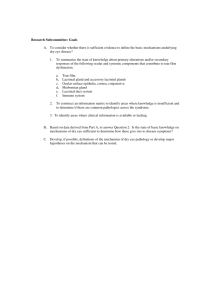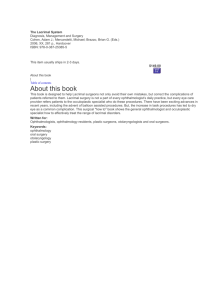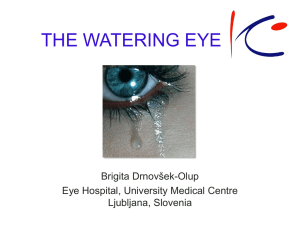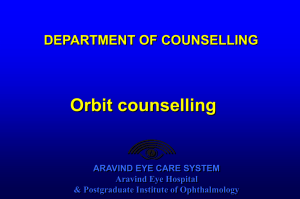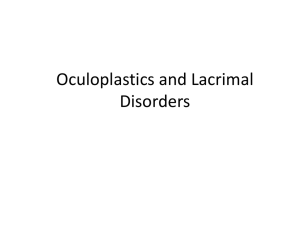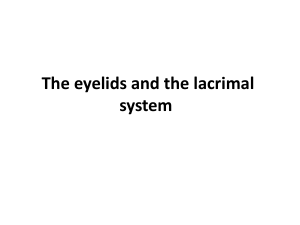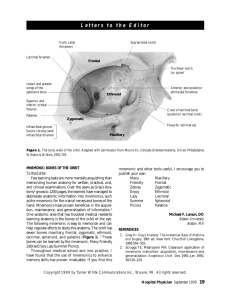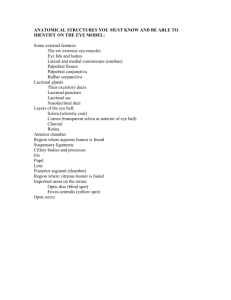The Tear Evaluation - Lynn's Lecture Help
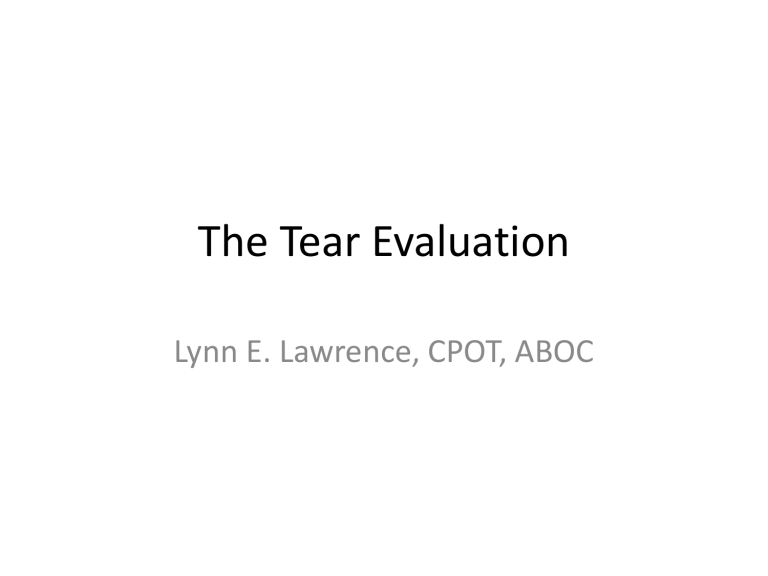
The Tear Evaluation
Lynn E. Lawrence, CPOT, ABOC
Terms
• Etiology – the cause of a disease or abnormal condition
• Dacryocystitis – inflammation of the lacrimal sac
• Epiphora – watering of eyes due to excess secretion of tears or obstruction of the lacrimal passage
Tear Film Layers oil snot
What functions does each layer of the tear perform?
aqueous
Tear Components
• Lipid Layer – prevents evaporation
• Aqueous Layer - hydration
• Mucus Layer – sticks tear to the eye
• Other components
Lipid Secretion: Meibomian Glands
Left:
Transillumination of eyelid showing meibomian glands
Right:
Secretion of lipid at lid margin
• The lipid layer restricts evaporation to 5-10% of tear flow
– Also helps lubricate
Mucin Secretion: Goblet Cells
Superficial layer of bulbar conjunctiva.
Goblet cells violet, epithelial cells blue.
• Soluble mucins
– Lower surface tension allowing tear film to spread over surface
Lipid Aqueous Mucin
Healthy Tears
• Antimicrobial proteins
• Growth factors & suppressors of inflammation
• Soluble mucin helps stabilize tear film
• Electrolytes for proper osmolarity (295-300)
– pH slightly alkaline (7.4)
A complex mixture of proteins, mucins, and electrolytes coated by a lipid layer
Anatomy
What function does the punctum have?
Punctum
Anatomy and Physiology of the ocular adnexa
• Eyelids
• Eyebrows
• Eyelashes
• Accessory glands
• Lacrimal Apparatus
What is the opening between the upper and lower lid called?
Lacrimal Apparatus
• Sometimes a person cannot produce natural tears that they might need some punctal plugs.
• Faucet
• Action
• Drain
Obstructive – vs- non-obstructive
Tear Production – Secretory
• Lacrimal gland
– Reflex tearing
– Too much tearing…epiphora
• Gland of Krause
– Superior fornix
• Gland of Wolfring
– Superior tarsal plate
Causes of Tearing
• Punctal agenesis/stenosis
• Poor/blocked drainage
• Trichiasis…minor entropion
• Superficial foreign bodies
• Poor pump action
– Eyelid mal-positions
– Lid distraction/punctal laxity
– Eyelid disease
• Tear deficiency /instability
• Trigeminal nerve irritation
Causes of Tearing Cont…
• Foreign body sensation
• Hypersecretion
– Lacrimal secretion and drainage imbalance
– Primary or reflex tearing
(reflex tearing is more common with ocular surface irritation)
• Lacrimal pump failure
• Lacrimal drainage obstruction
• Punctum location
• S/P Surgery
Fluid Pools and Connections
• Pools
– Eye
• Lacrimal lake
– Lacrimal Sac
– Nose
A tear lake higher than 2mm indicative of obstruction
The Connections
• Connections
– Lacrimal gland to the eye
– From the eye to the lacrimal sac
– From the lacrimal sac to the nose
Caniculitis can cause the blockage
What is in a blink?
• Lateral side higher than medial side
• Starts laterally and moves towards the medial and goes down the punctum
• The lid continues to close depressing the lacrimal sac and pushing tears towards the nasal duct
• This action also causes a suction for new tears
Eyelid Disease
• Anterior blepharitis - lids
• Posterior blepharitis glands
• Entropion
• Ectropion
• Droopy Eyelid Syndrome
• Cancer of the lids
• Cyst or lesions
• NLDO
Hypersecretion = Pump Failure
• Crocodile-tears
Syndrome
• Gustatory
Hyperlacrimation or
Gustatory epiphora or
Gustolacrimal reflex
(could be congenital)
• Ocular Surface
Irritation
Eyelid Positions
Disease:
• Trichiasis
• Entropion … drain
• Ectropion …drain
• Tear deficiency / instability
• Trigeminal nerve (5 th
CN) irritation
Lacrimal Pump
• Pump Action
– Lids
• Lateral/medial
• Muscles
• Disease
– Punctum
– Canniculli
• Lacrimal Sac
• Nasolacrimal Duct
• Facial Nerve Palsy (7 th
CN)
Nasolacrimal Obstruction
• Primary Acquired
Nasolacrimal Duct
Obstruction (PANDO)
• Nasolacrimal examination
• Office testing
Clinical Presentation
• Chief Complaint
• History of present illness
• Past medical history
• Clinical examination
• Nasal Examination
• Distinguish welling of tears from epiphora
• HPI = Onset, severity, consistency, frequency, nature of discharge, morning mucus, environmental factors, aggravating or alleviating factors
• Ask about punctal plugs
Chief Complaint
Cont…
• Hx of broken nose, sinus surgery, and location of tears
Treatments
• Medications/artificial tears…moisture/oil
• Punctal Plugs
• Botulinum Toxin
Injections into the lacrimal gland
(pg 979)
• Surgery…lids, DCR, tubes
Gee-Whiz Facts
• Children don’t start tearing until they are 6 weeks old
• 5% of children have NLDO
• Prognosis is decreased in children after 13 months
• Congenital glaucoma can cause reflex tearing due to photophobia
labeling
Reference
• Endoscopic Surgery of the Orbit and Lacrimal
System 2006… Acquired Nasolacrimal Duct
Obstruction David M. Mills M.D., Dale R.
Meyer M.D. FACS
• Images from EyeImaginations
